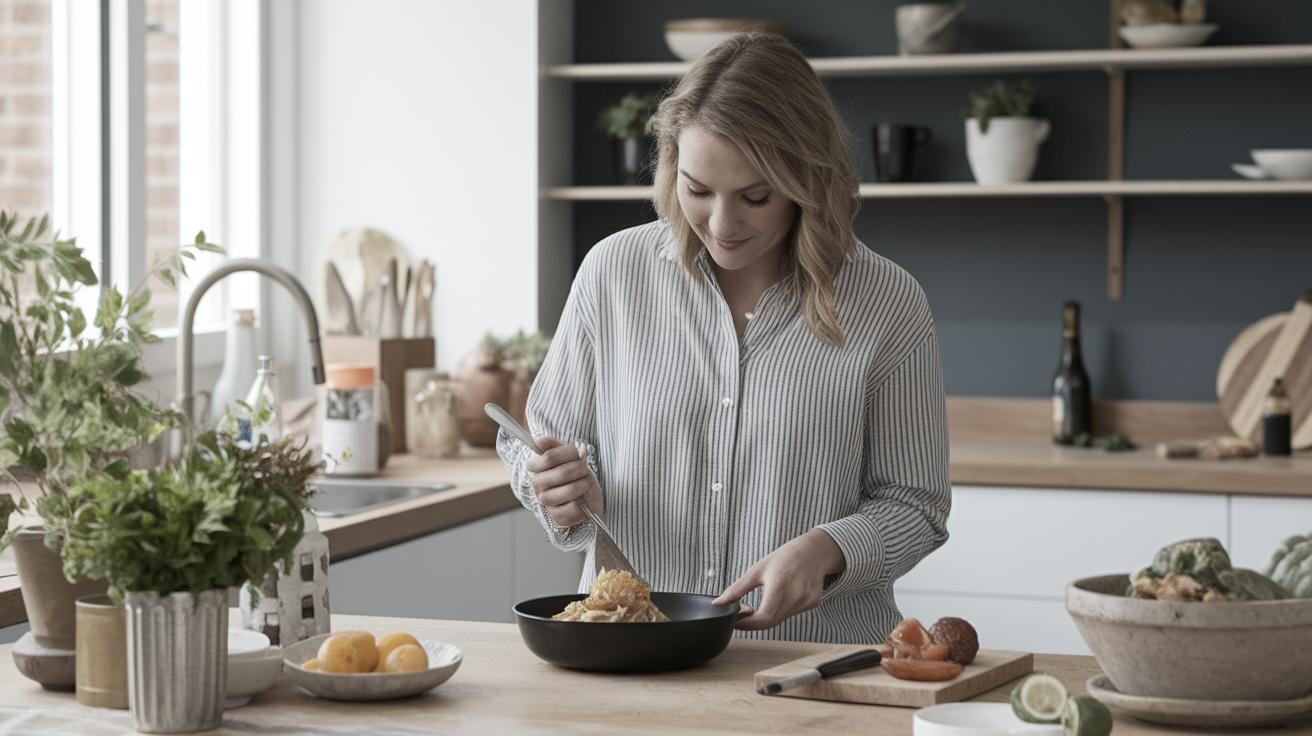Minimizing Burn and Fire Hazards in the Kitchen
Working in the kitchen can be a joyful experience, but it also comes with its share of risks, particularly when it comes to burns and fire hazards. From ensuring your kitchen environment is safe, to adopting careful practices during food preparation and cooking, there are multiple ways to mitigate these risks. This guide will walk you through the steps to creating a safer kitchen environment, offer techniques to prevent fires, and provide advice on avoiding cuts and burns. Each section is designed to equip you with knowledge and tips to keep your kitchen a haven of safety, enhancing your cooking experience while ensuring the well-being of everyone at home, including children and pets.
Start With a Safe(r) Kitchen
Watch Kids and Pets Carefully
The kitchen is a hub of activity and a natural gathering place, making it very appealing to children and pets. However, their presence can increase the risk of accidents. To safeguard your little ones and furry friends, establish clear boundaries. Consider using safety gates to keep them out of the kitchen during cooking sessions. Be sure that they know not to touch hot surfaces or kitchen utensils.
Supervision is key. If children are helping with meal prep, provide them with age-appropriate tasks and tools. Educate them on kitchen safety fundamentals, like keeping pot handles turned inward, away from the edge of the stove. Pets, too, should have designated areas away from cooking zones to avoid tripping hazards.
Dress for the Occasion
Wearing the right attire in the kitchen is more than just about looking the part. Loose clothing or accessories can catch fire or get tangled in appliances. To reduce risk, opt for fitted clothing and keep long sleeves rolled up. Tie back long hair to prevent it from coming into contact with flames or getting caught in mixers.
Proper footwear is also essential. Closed-toe, non-slip shoes can protect your feet from spills and dropped utensils, minimizing the potential for injuries. Investing in a good-quality apron not only keeps your clothes clean but adds an extra layer of protection against splashes and spills.
Don’t Start Fires
Preventing fires is a critical component of kitchen safety. The first step to achieving this is to never leave cooking food unattended. Distractions can lead to disastrous consequences. Set timers and stay focused on the task at hand. Make sure the area around your stove and oven is free from flammable materials like paper towels or dish rags.
A clean kitchen is a safe kitchen. Regularly clean your stovetop, oven, and range hood to prevent grease buildup, a common fire hazard. Equip your kitchen with a fire extinguisher that is rated for grease fires and know how to use it. Installing a smoke detector nearby adds an additional layer of protection.
Avoid Cutting Yourself
Handle Knives and Other Blades With Care
Knives are an indispensable kitchen tool but can be dangerous if handled improperly. Keep knives sharp and handle them with care, as dull blades are more likely to slip and cause injury. Use a cutting board, ideally non-slip, and ensure it is stable and secured.
When chopping, maintain a claw grip with your non-dominant hand to keep fingers safe from the blade. Always direct the blade away from your body and keep your eyes on your work. After use, store knives properly in a knife block or magnetic strip, out of reach of children.
Don’t Underestimate Can Openers
Manual can openers, when used improperly, can become a hazard. Ensure the blade and gears of your can opener are kept clean and sharp to facilitate smooth operation. Avoid using a damaged or rusted can opener, as it may slip and cause cuts.
Electric can openers should be operated with caution, ensuring lids are removed without sharp edges. Dispose of lids immediately to prevent accidental cuts or ingestion by children and pets. Always store can openers securely after use.
Don’t Cut Corners With Mandolines
The mandoline is a handy tool for precise, uniform slicing but can be dangerous if misused. Always use the handguard that comes with the mandoline to protect your fingers, and never attempt to slice food too small to hold securely.
Invest in a cut-resistant glove for added protection. Focus on the task when using a mandoline; distractions can lead to serious injury. Clean and store the mandoline safely, avoiding leaving it in sinks where others might not see it.
Use Appliances With Blades Safely
Bladed kitchen appliances, such as food processors and blenders, require careful handling. Always ensure the appliance is turned off and unplugged before inserting or removing blades. Read the manufacturer’s instructions for assembly and disassembly carefully.
Avoid reaching into the appliance with your fingers. Use a spatula or designated tool for removing food. Store blades safely, away from the reach of children. Regular maintenance of these appliances will ensure their efficient and safe operation.
Handle Breakable Glassware or Dishes Gently
Glassware and ceramic dishes can pose sharp hazards when broken. Handle these items with care, especially when they’re wet and slippery. Avoid stacking too high or forcing them into too-tight spaces, which can lead to breakage.
In case of breakage, clean up immediately using appropriate safety gear like gloves and a broom to sweep up shards. Dispose of broken pieces safely to prevent injuries. When washing, inspect for chips or cracks that could compromise the integrity of the items.
How to Avoid Burning Yourself
The Stovetop
When working at the stovetop, exercise caution to prevent burns. Use oven mitts or potholders when touching pot handles or lids. Keep stovetop surfaces free from clutter to avoid accidental contact with hot elements.
Be mindful of steam when lifting lids; tilt them away from you to allow steam to escape safely. Adjust burner flames to the size of your cookware to minimize exposure and ensure efficient heating. Avoid wearing loose clothing or sleeves that could catch fire.
Pots and Pans
Pots and pans, especially when filled with hot liquids, require careful handling. Ensure that handles are securely attached and always use two hands when moving large pans. When boiling liquids, be mindful of bubbles that can splatter and cause burns.
Never leave spoons or other utensils in the pot while cooking on the stovetop, as they can become hot and pose a burn risk if accidentally touched. To mitigate risk, turn pot handles inward, away from the edge of the stovetop, to keep them from being knocked over.
While Cooking
While cooking, stay vigilant and keep safety in mind. Use wooden or silicone utensils, which tend not to retain heat like metal ones, reducing burn risks. Consider investing in a kitchen timer and plant it in your routine to minimize distractions.
Incorporate a habit of tasting and stirring frequently, but always use a spoon or ladle. Avoid using your fingers to test temperature. Additionally, keep a lid or baking sheet nearby to smother small grease fires quickly and safely.
While Baking, Roasting, or Using the Broiler
Baking and roasting often involve very high temperatures, which increase burn risks. When using the oven, always use oven mitts to handle racks and trays. Keep your face a safe distance when opening the oven door to avoid a blast of hot air.
When broiling, position food correctly on the rack to avoid close contact with the heating element. Supervise the oven while broiling, as foods can burn quickly. Always turn off the oven when finished, and wait for it to cool down before cleaning.
When Using Baking Dishes
Baking dishes can become very hot and heavy. Use two hands to support them securely when moving. Glass or ceramic dishes should be handled with caution to prevent thermal shock, such as moving a hot dish directly to a cold surface, which can cause breakage and burns.
Be sure your kitchen timer is set to avoid forgetting dishes in the oven, which can become unexpectedly hot. To prevent accidents, make a habit of nudging dishes into the center of the oven racks to avoid spills when maneuvering them.
When Using Appliances With Heating Elements
Appliances like toasters, rapid ovens, and electric kettles feature heating elements that can burn if not handled appropriately. Position these appliances away from flammable materials and ensure there is enough space for heat circulation.
Always allow these appliances to cool down completely before cleaning. For toasters, unplug before prying out stuck toast. Use the appliances’ handles or knobs for optimal safety and consistently check the power status to avoid surprises.
May 2020
During this period, many found themselves spending more time in the kitchen due to global lock-downs. The increase in kitchen activity has been twofold: an opportunity to develop cooking skills and an uptick in potential hazards. Incorporating safety practices can mitigate risks.
May 2020 highlights the need for more awareness regarding kitchen safety. Implementing these guidelines can prevent accidents and injuries, ensuring a healthy relationship with newfound culinary enthusiasm. Focus on safety can turn kitchen time into a serene and pleasurable experience.
Final Thoughts
| Safety Aspect | Key Points |
|---|---|
| Start With a Safe(r) Kitchen | Supervise children and pets; dress appropriately for kitchen tasks. |
| Don’t Start Fires | Keep cooking attended; clean stovetops and have a fire extinguisher ready. |
| Avoid Cutting Yourself | Use knives carefully; handle appliances with blades safely. |
| How to Avoid Burning Yourself | Use oven mitts; be cautious when working with stovetops and ovens. |


